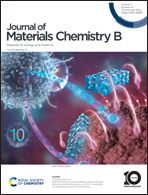Engineered elastin-like polypeptide-based hydrogel delivering chemotherapeutics and PD-L1 antibodies for potentiated cancer immunotherapy†
Abstract
Immune checkpoint inhibitors (ICIs) have effectively eradicated advanced tumors by inducing durable and systematic antitumor immune responses. However, when used as a standalone treatment, ICIs typically exhibit a low response rate in many cancers. In this study, we engineered an in situ-formed gel depot using elastin-like polypeptides (ELPs) to efficiently deliver PD-L1 antibodies (aPD-L1) and gemcitabine (GEM) for enhanced immunotherapy in melanoma. Sustainably released chemotherapeutics from gel depots could kill melanoma cells and promote PD-L1 upregulation in tumor cells. Moreover, aPD-L1/GEM-encapsulated ELP hydrogel promoted a 3.0-fold increase of tumor-infiltrated CD8+ T cells and 60% Tregs depletion compared with PBS group, eliciting a robust antitumor immune response for immunotherapy in melanoma mouse models. This research highlights the promising potential of ELP-based hydrogels in delivering ICIs and chemotherapeutic agents for potentiated cancer immunotherapy.

- This article is part of the themed collection: #MyFirstJMCB


 Please wait while we load your content...
Please wait while we load your content...